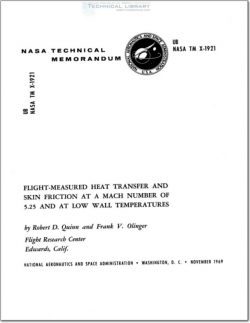NASA-TM-X-1921

- Version
- 196 Downloads
- 1.41 MB File Size
- 1 File Count
- June 15, 2016 Create Date
- June 15, 2016 Last Updated
Flight Measure Heat Transfer and Skin Friction at a Mach Number of 5.25 and at Low Wall Temperatures

Skin temperatures, shearing forces, and surface static pressures were measured
simultaneously on a test panel installed on the sharp—leading—edge upper vertical tail
of the X—15 airplane. The data were obtained at a nominal free—stream Mach number
of 5. 25 and wall—to-recovery temperature ratios of 0. 218 to 0.333. Th8 free—stream
Reynolds number had a nominal value of 1. 54 x 106 per foot (5. 05 X 10 per meter).
Turbulent heat—transfer coefficients and turbulent skin-friction coefficients were derived
from skin—temperature time histories and shear—force measurements, respectively.
Also, Reynolds analogy factors were obtained from the measured heat—transfer
coefficients and the shearing—stress measurements.
Skin—friction coefficients calculated by the theory of van Driest, Eckert's reference
enthalpy method, the Spalding and Chi method, and the adiabatic reference enthalpy
method were compared with experimentally determined values. The skin—friction
coefficients predicted by the Spalding and Chi method were in excellent agreement with
the measured data. The experimental Reynolds analogy factors were compared with
values predicted by the methods of Rubesin, von Karman, and Colburn. The experi—
mentally obtained value of 1. 4 was 14 percent to 25 percent higher than the calculated
values. Heat—transfer coefficients calculated by using a modified Reynolds analogy
between skin friction and heat transfer were compared with measured values. The
Spalding and Chi method-together with a Reynolds analogy factor of 1. 4 predicted heat-
transfer coefficients that were in excellent agreement with the measured data. However,
when a more commonly used Reynolds analogy factor of 1. 2 was applied, values
predicted by the theory of van Driest agreed best with the heat—transfer data.
The importance of being able to predict turbulent skin friction and heat transfer for
the design of missiles and hypersonic and supersonic vehicles is well known. A large
number of empirical and semiempirical theories are available which can be used to
predict skin friction and heat transfer at high Mach numbers and low wall temperature
ratios. However, values predicted by the various theories usually differ substantially,
and, therefore, recourse to experiments must be made to determine the validity of the
theories. Unfortunately, data obtained from experiments have also differed. Further,
most of the experiments have been performed in wind tunnels, making it necessary to
extrapolate to flight conditions.
| File | Action |
|---|---|
| NASA-TM-X-1921 Flight Measure Heat Transfer and Skin Friction at a Mach Number of 5.25 and at Low Wall Temperatures.pdf | Download |

Comment On This Post